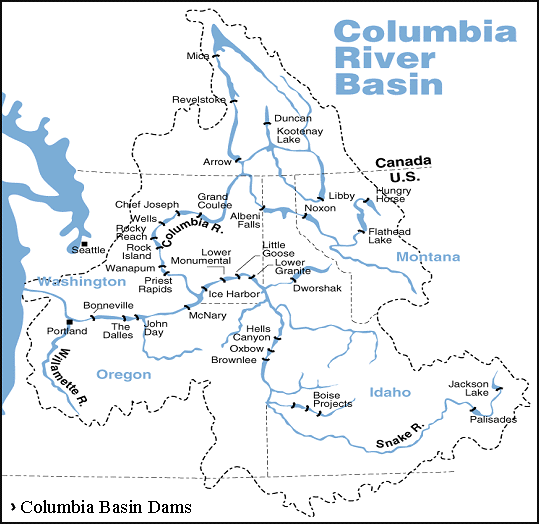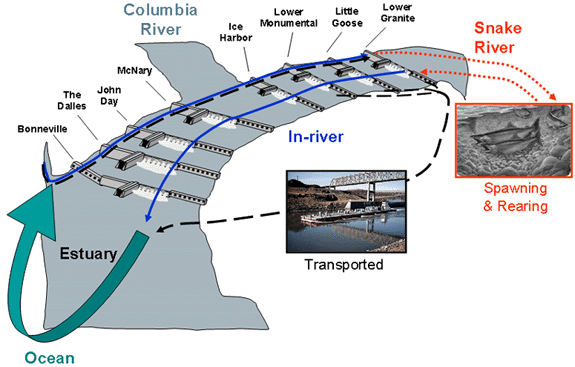CSMEP Hydrosystem Monitoring and Evaluation Designs
The existence and operation of the Federal Columbia River Power System (FCRPS) is one of the more important anthropogenic factors influencing mainstem survival of listed and proposed ESUs. Decisions on FCRPS actions can directly or indirectly affect survival of these stocks. Monitoring of the expected and actual effectiveness of these actions (e.g., juvenile collection, bypass, and transportation; water management; offsite mitigation) is essential for reliable decisions.

CSMEP's Hydro workgroup is evaluating a subset of hydro management questions across several scales:
- individual projects
- survival by different passage routes through the hydrosystem, and
- overall life cycle survival
These different scales relate to a variety of decisions: operations at individual projects (e.g., spill, bypass, removable spillway weirs); overall operations (e.g., when to transport fish within season, compliance with hydrosystem biological opinions), longer term hydrosystem decisions (e.g., flow management, effectiveness of transportation over multiple years, system configuration); and adequacy of hydrosystem operations for stock recovery. Moving along these scales, the performance measures of interest change. Performance measures range from direct survival at and between dams, to smolt-to-adult survival rates (e.g., smolts leaving Lower Granite Dam to adults returning there 2-3 years later) to inferences about delayed mortality from contrasts in mortality patterns (contrasts in recruits/spawner or smolt-to-adult survival rates). At the largest scales, other factors come into play (estuary, ocean, harvest, etc.) which make it harder to isolate the signal from the hydrosystem.
The choices that are available to improve the quality of information for hydrosystem decisions, and reduce the risks of making incorrect decisions, include: the number of years of data collected, the magnitude of tagging effort, the number of stocks that are monitored, the ability to filter out year to year natural variation and isolate the signal of management actions, and implementation of deliberate manipulations of hydrosystem operations to reduce uncertainty in effectiveness evaluations. Our analyses indicate that for some questions, simply adding more tags won't improve the quality of information unless one can filter out the effects of year to year natural variation. CSMEP has developed, and is continuing to assess alternative methods of data analysis that filter out this variation. For many of these questions, CSMEP has developed low, medium and high alternative designs and explored the strengths and weaknesses of each approach.
Hydrosystem Scales

Illustration of the different scales of interest for monitoring the effects of the hydrosystem on salmon survival rates: survival at individual projects, survival by different passage routes through the entire hydrosystem, post-Bonneville survival of different groups of fish, smolt to adult return rates back to Lower Granite Dam, and overall life cycle survival back to the spawning ground. Moving from smaller to larger scales results in more confounding from other factors (ocean conditions, hatcheries, harvest), but also provides an assessment of indirect effects over a larger portion of the life cycle. The CSMEP Hydro Subgroup is integrating monitoring designs with other CSMEP subgroups, particularly related to PIT-tagging.